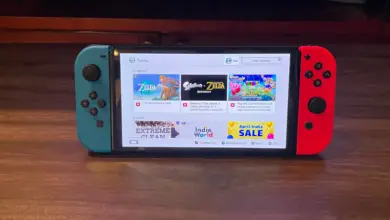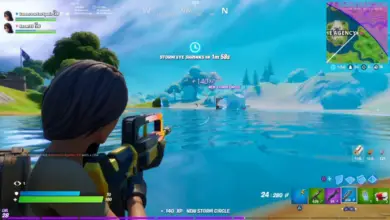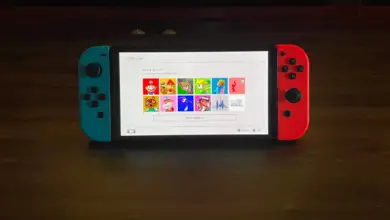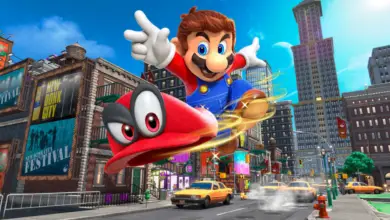What Modes are Available in Splatoon 3 at Launch?
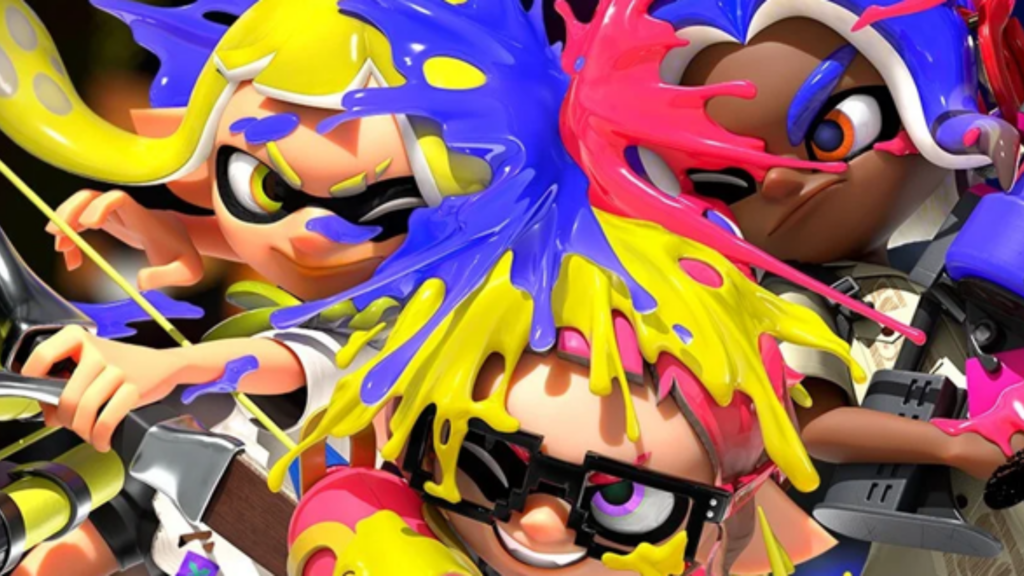
Splatoon 3 is the latest entry in the Splatoon franchise, and so far, it has been an incredible success. It has sold incredibly well, especially in Japan, and it has received respectable reviews as well. But what does this say about the selection of game modes? Splatoon 3 has a number of modes, including the main mode, Turf War. But what modes are available for use at launch?
What Modes are Available in Splatoon 3 at Launch?
Splatoon 3 has many of the same modes present in the preceding two Splatoon games. Most modes play the same, so if you already know Splatoon like the back of your hand, you know what you are getting for the vast majority of these modes.
Regular Battle and Private Battle
With Regular Battle, each mode is a 4 v 4 Player VS. Player battle, and all battles are timed. The first mode, Turf War, is available at all times, but the other modes rotate, much like the stages in the modes. The modes also all have a time limit. Private Battle is the same, except played between friends instead of random players.
Turf War
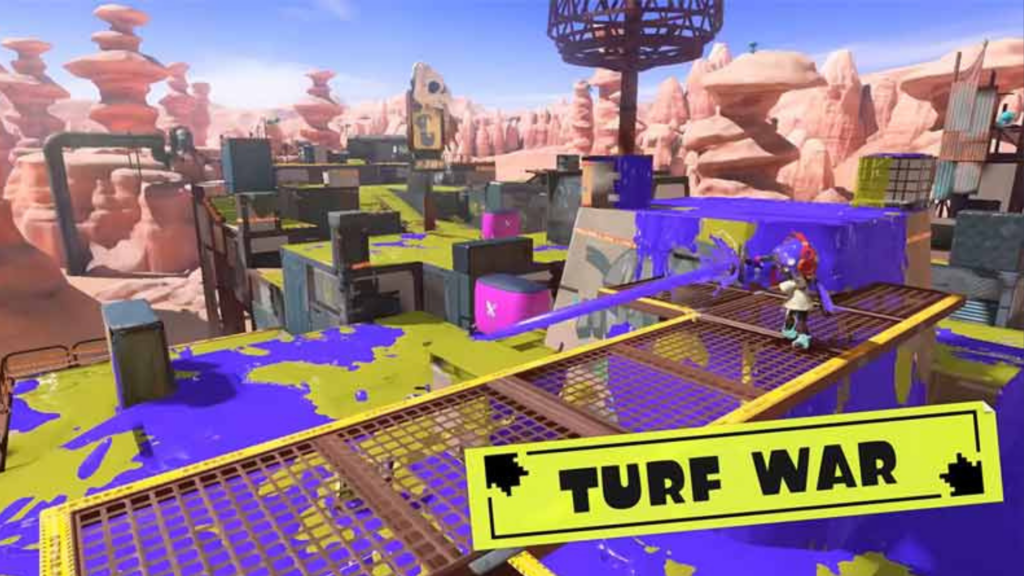
This is the standard multiplayer mode, and by far the one mode people know Splatoon most by. Like most Splatoon modes, this is a 4 v 4 mode. In it, the goal being to cover as much of the area with your color ink as possible while competing with another team trying to do the same. All the while, you have to contend with your opponents trying to wipe you and your team out. Once the time has run out, the game determines how much a percentage you cover compared to the opponent.
Splat Zones
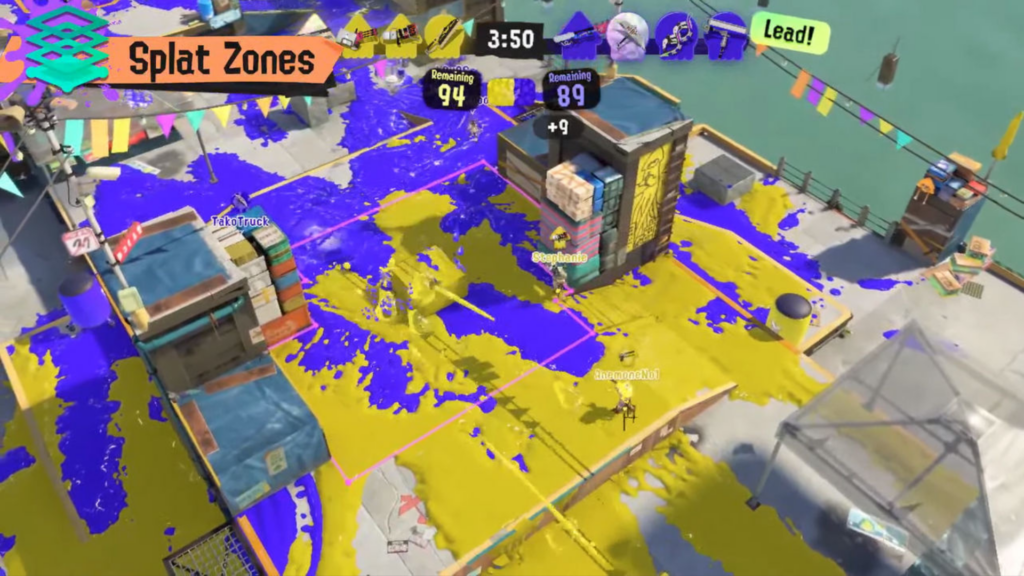
In Splat Zones, the objective is to control certain zones by keeping them inked with your color. The longer you keep the zones in your control, the close you get to hitting the goal (which is hit once your number hits zero). If control is lost, however, their number begins to count down, and once control is regained, there will be an extra countdown that needs to finish before your original countdown can resume.
This mode will go to overtime if neither team has reached zero and the losing team has control. At this point, the losing team has to control it until their number falls below the opponent’s. However, if the losing team ever loses control, the round ends in the winning team’s favor.
Tower Control
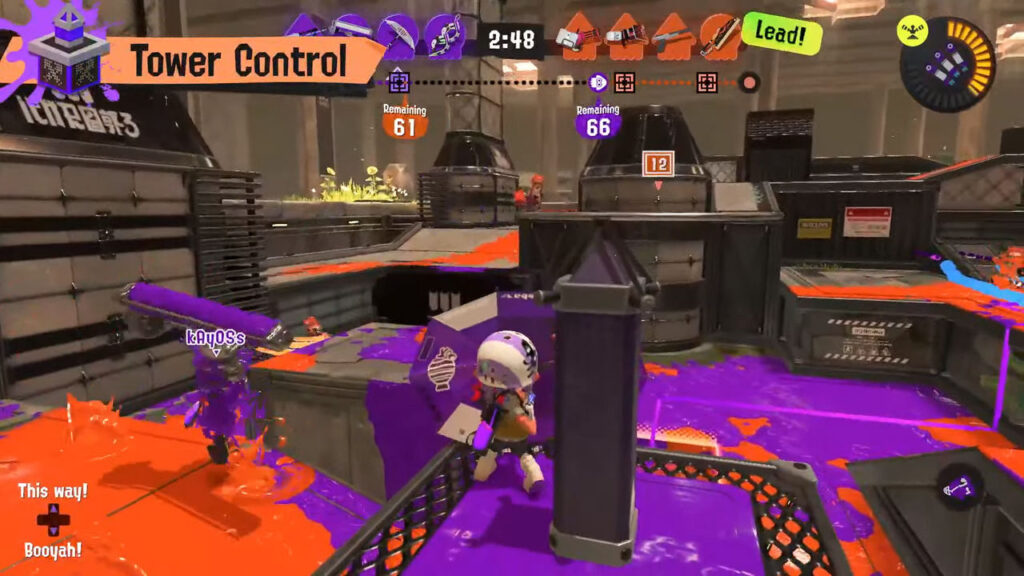
In Tower Control, the objective is to reach a tower located in the middle of the map and get on top of it. Once this is done, the tower will begin moving along a predetermined track towards the opponent’s side. The tower turns your color when you are on it, and the opponent’s when they are on it. If neither is on it, it will assume a neutral color and eventually begin to return to the center. If both opponents are on the tower, the tower will not move unless there are more of one team than another.
Along the way, you will sometimes hit checkpoints. Once a checkpoint has been reached, the tower will stop for a handful of seconds before clearing it. This means that, if you lose control of the tower, you don’t have to redo that checkpoint once you regain control. If neither side has won by the end of the timer, the team in the lead wins, or if the losing side is in control, they win if they can take the lead before they lose control.
Rainmaker
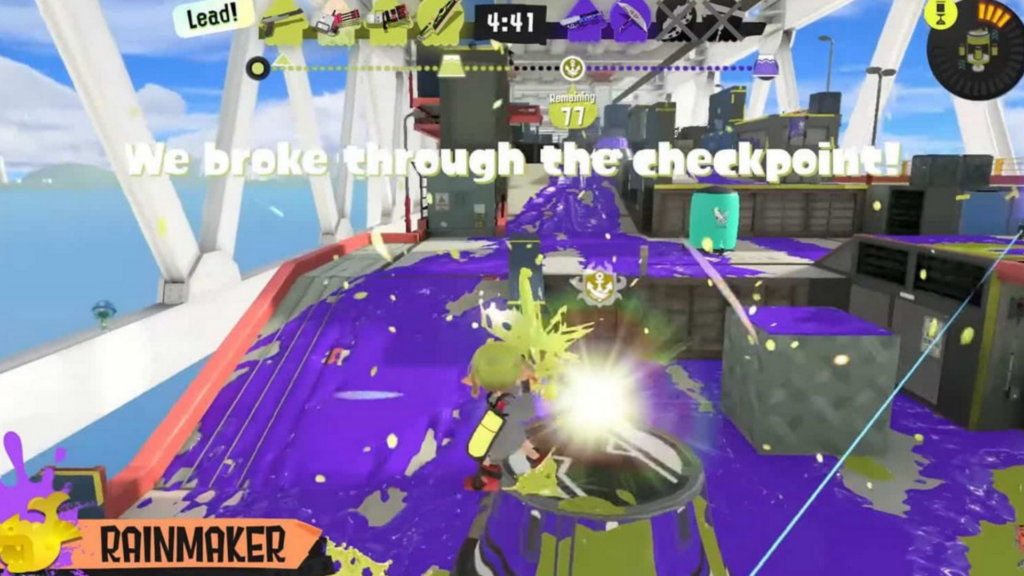
In this mode, the objective is to be the first to collect the Rainmaker in the middle of the stage. To collect it, you have to shoot it, which causes a bubble of your ink to expand around it. When the opponent shoots the bubble, the bubble shrinks, and may be overtaken by the opponent’s color. Once the bubble grows large enough, it pops, splatting all Inklings and/or Octolings of the opposite color nearby.
The Rainmaker, as an item, has two functions. The first is to be placed on the opponent’s side of the map, which is the objective. The second is as an extremely powerful weapon, which can be utilized by the player who collects it. While you can elect to try to carry it all the way to the other side of the map, sometimes it’s better to take a bit to just blast your opponents with it. It can be fairly risky, but it also allows your partners to gain ground (literally).
If the winning side loses the Rainmaker in the last 15 seconds, either team has the chance to get the Rainmaker. However, if the losing team does not get it in the first 10 seconds, the overtime ends. If the timer ends with the losing team in control, they have the chance to win if they keep it until they take the lead.
Clam Blitz

In Clam Blitz, players must collect Clams to create Power Clams. Once you have these Power Clams, your objective is to use them to breach the opponent’s barrier and then put them in your opponent’s basket to get points. To win, you either need to hit 100 points worth of Power Clams or have the most points when the time runs out. If the losing team, when the timer runs out, has the opportunity to take the win, if they either have a Power Clam still or if the winning team’s barrier is open.
Anarchy Battle, League Battle, and X Battle
Anarchy Battle is essentially everything discussed above, except more skill-focused and including a rank system (with you starting out at rank C-). League Battle is the same, except team-based. Finally, X Battle is for people who are Rank X. These modes can only be played once you hit level 10.
Salmon Run Next Wave
After its debut in Splatoon 2, Salmon Run is better than ever, thanks to it being available 24 hours a day, seven days a week. This mode is a Player VS. Enemy (PVE) style, where the objective is to collect Salmonid eggs from the Salmonids that are raiding the area you’re in. It starts off relatively light, especially if you have a lower Salmon Run rank, but as you play more, the matches get incredibly chaotic. You have to progress through three rounds and hit the Salmonid Egg minimum number in each round to succeed.
There are various Boss Salmonids you may encounter, each with its own specialty. Some are more easily beaten up close, while others are safer when approached from afar. However, there are special bosses as well, and even the King Cohozuna, which provides greater rewards when splatted (though it can be a little uneven when it comes to the quality of the rewards).
Splatfest
This mode comes every once in a while, and is conducted as a competition between chosen sides. However, one new feature of the Splatfest is that there are three teams instead of two. Both Splatoon and Splatoon 2 use two teams, with each of the two idols from those games (Callie/Marie and Pearl/Marina) picking one of two sides.
This game has three idols – Frye, Shiver, and Big Man, adding that third option. For example, the first Splatfest was a competition between rock, paper, and scissors, and the most recent one was between Grass, Fire, and Water types from Pokemon. Picking a winner is determined by multiple factors, including popularity and performance, which are determined once the Splatfest period ends. The Splatfests use the Turf War mode, but some things may change, including the available ink colors and the music.
In this game, most Splatfest matches are 4 v 4 like they have been in previous entries, but there is a new kind of fight that is meant to accommodate the new 1 v 1 v 1 choice. Basically, during the Splatfest period, some battles may have members from all three teams compete in a thing called Tri-Color Turf War.
Instead of the Turf War being three teams of four, the leading team of four players is placed in the middle, while two players from the other two teams approach from opposing sides, working together against the first-place team. However, the leading team also needs to protect the Ultra Signal, which, when used, causes one of the members of the idol team to place a Sprinkler of Doom that sprays that team’s color all about.
The concept of expanding the number of teams or the number of players has been one that has been suggested ever since the original Splatoon, though honestly, a lot of people were kind of disappointed with the execution of this mode. The finding is that it’s simply not very fun, and not at all balanced. Many have reported that being in the defending team tends to be a very uphill battle to victory. Hopefully, Nintendo will either balance the mode better, or remove it altogether. It’s an interesting concept, but the execution seems rather poor.
Return of the Mammalians
Each Splatoon game has a single-player mode, and this game’s mode is called Return of the Mammalians. You start out with your Salmonid Smallfry, and you must work with Cap’n Cuttlefish to get through some strange, furry blobs to solve the disappearance of the Great Zapfish (which keeps disappearing game after game!). This mode features the return of Callie, Marie, and Agent 3 (the latter being the protagonist of the first Splatoon’s single-player campaign), and also features Frye, Shiver, and Big Man.
Table Turf Battle
This is a strange side mode, where players compete against each other using cards. It is designed in such a way as to resemble a regular Turf War using a deck of cards that can be expanded with card packs found.
Unreleased modes
While there are several modes that have already been released, there are actually two modes that have been confirmed to be on the horizon.
Big Run
This mode is a variant of Salmon Run, but with the twist being that other levels besides the original Salmon Run levels are invaded by Salmonids. Basically, any regular Turf War level can be played during this mode, with some modifications made to it. The lower areas of the map fill with water, and the sky turns red (much like it does with Salmon Run normally). It will likely feature many of the same Boss Salmonids and other enemies, though whether something like King Cohozuna will appear during Big Run is anyone’s guess.
The mode has yet to be featured in Splatoon 3, though it is expected to appear sometime before the end of 2022. When it appears, it will be available for a limited amount of time, before the mode is disabled again, only to be re-enabled a few months down the line.
DLC Campaign
Much like with Splatoon 2’s Octo Expansion downloadable campaign, Splatoon 3 is going to have a second campaign available. It seems like it could have similar ideas behind it, since Splatoon 2’s idols – Pearl and Marina – appear to be featured in the campaign in some way. This could mean that Octo Expansion’s unique nonlinear structure and interesting challenge modes could also make a return.
It is still in development, and a release date has yet to be confirmed. If we had to speculate, the launch of Octo Expansion was a year and one month after the release of Splatoon 2, so we might see it come out sometime in October 2023. Yet, circumstances could cause that wait to be shorter or longer. For example, if they were developing the content simultaneously with Splatoon 3, it could be finished significantly faster. If it’s meant to be an Octo Expansion 2, it could even release on August 8, much like Octo Expansion did back in 2018.
As far as cost goes, if Octo Expansion is anything to go by, this game could cost $19.99 – though, again, that is not necessarily set in stone. For people who own the Nintendo Switch Online Expansion Pass, however, it’s possible that Nintendo may give them access to the DLC for free. Octo Expansion was eventually made available, and paid DLC for both Mario Kart 8 Deluxe and Animal Crossing: New Horizons (among others) were made available for Expansion Pass users. Whether they do it with this game too remains to be seen, but it would be a good idea if they did so.
- How to Pair Meta Quest 3 Controllers with Your Quest 3 Headset: A Quick Guide
- How to Charge Meta Quest 3: A Guide to Powering Up Your VR Experience
- How to Cast Meta Quest 3 to Samsung TV: A Step-by-Step Guide
- How To Factory Reset Your Meta Quest 3: A Step-by-Step Guide
- How to Power On and Off the Meta Quest 3


